The Art of Walking
October 4, 2018
“Walking is finding an impromptu studio in a place you never expected. Marking territory. Remembering. Picking up things. Making eye contact. A walk is never the same twice. Writing notes to self. Losing one’s way. Talking to yourself. A chat with a stranger. Going with the unexpected. Being surprised by what you find. Marking the journey with objects, the milestones of moments. Unexpected encounters. The desire to be in a new situation. Be somewhere different. Revisiting the past. Caught up with what’s going on. Making do. Taking the long way home. Getting as far away from home as possible. Being curious. Nonchalant. Indecisive. Having a route mapped out. Going off course. Letting things happen. Every so often taking a rest. Time-out. In between places. Both lingering and counting steps. Not knowing what’s around the corner” (Pamela Whitaker, The Art of Walking)

Photos: David Renault and Mathieu Tremblin, Les Frèrers Ripoulain, Human Hall of Fame, 2010, Nantes France, Walking Graffiti – Sandwich Boards for Collective Art Making
“David Renault and Mathieu Tremblin work together as Les Frères Ripoulain and their partnership seeks to address issues that they describe as ‘vandalism and anonymity, space and solitude, silence and invisibility, strangeness and secrecy…[What interests the artists is the classical graffiti tag]…not the tag’s status as ornament or decoration, but its relationship with territory—its role in the acquisition and stealing of space. Tags can be seen as the diametric opposite of commercial advertising whereby people buy space to publicise the product they want to sell.” Reference: The World Atlas of Street Art and Graffiti by Rafael Schacter.
Interartive: Walking Art/Walking Aesthetics
https://walkingart.interartive.org
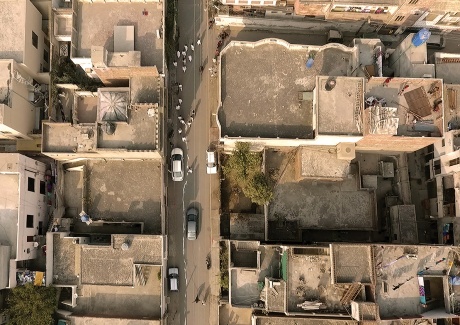
Honi Ryan. Walking Presence. 2016. Photo by Kashif Saleem.
The Elastic City: Participatory Walks Curated by Artists
Photograph, Elastic City, https://www.elastic-city.org/about
https://www.elastic-city.org/about
“Elastic City intends to make its audience active participants in an ongoing poetic exchange with the places we live in and visit. Artists are commissioned by Elastic City to create their own participatory walks for the public, often using sensory-based techniques, reinvented folk rituals and other exercises to investigate and intervene in the daily life of the city, its variously defined communities, and the politics of individual and group identity”
Link to the Book Prompts for Participatory Walks edited by Todd Shalom.
https://drive.google.com/file/d/1sh-Tk50R2bT0ChRiYzJdzdWH1wetsTRv/view
Prompts for Participatory Walks
https://www.elastic-city.org/prompts
Elastic City Videos
https://www.elastic-city.org/videos
Meredith Monk and Vocal Ensemble performing Songs of Ascension at Ann Hamilton’s Tower, Oliver Ranch, Geyserville CA, Oct 2008
The Walking Lab: Performing Lines and Research-Creation
“Performing Lines: Innovations in walking and sensory research methodologies is a partnership research-creation project to study and advance the theory and practice of walking methodologies, exploring and developing innovative interdisciplinary practices”. Stephanie Springgay and Sarah Truman.
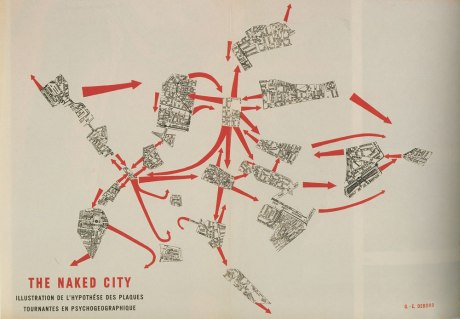
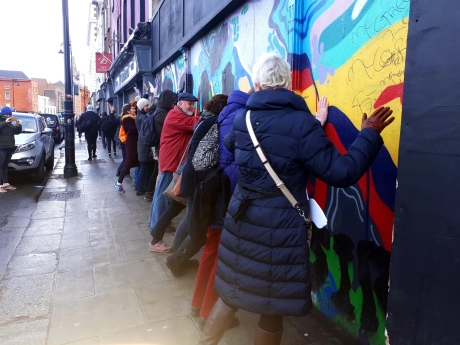

Photos Above: Walking Off Course, The First Fortnight European Mental Health Art and Culture Festival, 2019
Agnes YOSHII, Japan, Contemporary Dance Unit, Minimal Performances
Janet Cardiff and George Bures Miller, Video Walk
Produced for dOCUMENTA (13), Kassel Germany.

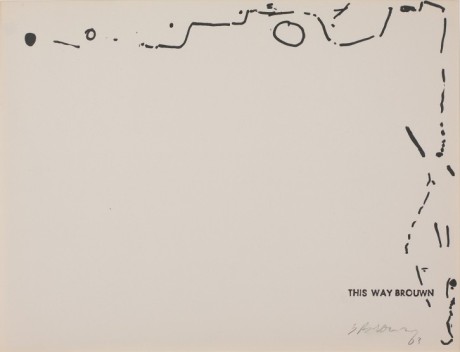

Artworks Above: This Way Brouwn and Steps of Pedestrians on Paper by Stanley Brown
“This Way Brouwn is made up of doodles drawn by pedestrians who Brouwn asked for directions, and whose simple maps he later appropriated by stamping them with the title of the series…one sheet is left blank by a passer-by who didn’t know the itinerary. The sheets, either marked or untouched, not only highlight the social dimension of walking, but also point to the subjective experience of distance and geography as opposed to the standardized conventions of cartography and topography.” (Stanley Brouwn by Jan Mot in Frieze)

Wanderlust by Rebecca Solnit Quotations
“Walkers are ‘practitioners of the city,’ for the city is made to be walked. A city is a language, a repository of possibilities, and walking is the act of speaking that language, of selecting from those possibilities. Just as language limits what can be said, architecture limits where one can walk, but the walker invents other ways to go.”
“Walking shares with making and working that crucial element of engagement of the body and the mind with the world, of knowing the world through the body and the body through the world.”
“When you give yourself to places, they give you yourself back; the more one comes to know them, the more one seeds them with the invisible crop of memories and associations that will be waiting for when you come back, while new places offer up new thoughts, new possibilities. Exploring the world is one of the best ways of exploring the mind, and walking travels both terrains.”
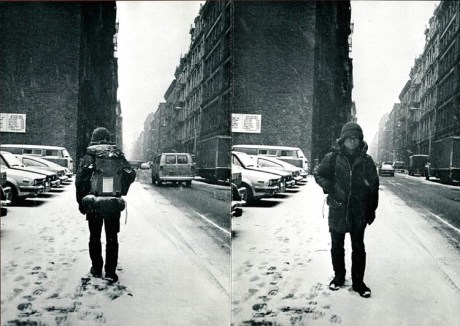
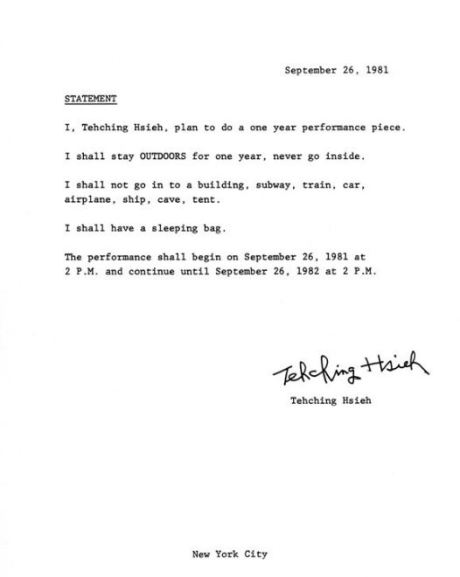
Photo: Artist Tehching Hsieh, One Year Performance, 1981-1982 “The artist spent a year outdoors moving around New York City with only a sleeping bag and a few other belonging” (Reference: Walking and Mapping: Artists as Cartographers by Karen O’Rourke)

Photographs: Song Dong, A Pot of Boiling Water, 1995, Beijing
Stories from the Walking Library (2014) by Deirdre Heddon and Misha Myers in Cultural Geographies
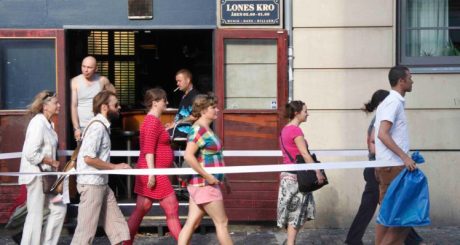
Photo: Gustavo Ciriaco, “Here Whilst we Walk”
“Inspired by the long tradition, which links walk to the production of thought and awareness, the artists Andrea Sonnberger and Gustavo Ciríaco take the public for a silent walk using as device a big rubber band. The two performers start a journey through the city, investing on the possibilities of inhabiting the urban space through another politics of sharing and of perception…A contact in displacement where the place shall always be moving and moved.” (Gustavo Ciriaco and Andrea Sonnberger)
Bruce Nauman, Walking in an Exaggerated Manner Around the Perimeter of a Square, 1967-1968.
Our Story of Resistance by Vickey Curtis, Dublin

Vickey Curtis is a spoken word artist. Her performance A Rose By Any Other Namespoke the language of street harassment in the course of a walk from the Spire to Rathmines in Dublin. Read a witnessing of her performance that was part of the Dublin Live Art Festival 2016 in:Action/Irish Live Art Review. Photograph by Blue Print Photography, Dublin.
Canadian artists Shawn Micallef, James Roussel and Game Sawhney, showcase the power voices carry to define places. They record personal stories about neighbourhoods and city streets. Murmur broadcasts oral histories for others to hear within everyday walking routes. The video above is a Ted Talk by Shawn Micallef examining the urban/suburban divide in Toronto.
Photos Above: Floats in the Aether, Amanda Coogan
“Floats in the Aether is an ambitious, large-scale performance comprising a series of events involving over 100 women and girls of different backgrounds and social contexts. In each event, Amanda Coogan will lead a silent, slow-moving, choreographed procession through the historic rooms of the National Gallery of Ireland (Dublin). Each participant wears a simple cream jacket with gold, purple, orange and green painted details to reflect the colours of the Irish suffrage movement. Coogan believes ‘this performance puts groups of women together in the spirit of community, togetherness, witness and expectation to remember and celebrate the work of the Irish suffragettes…” http://www.amandacoogan.com
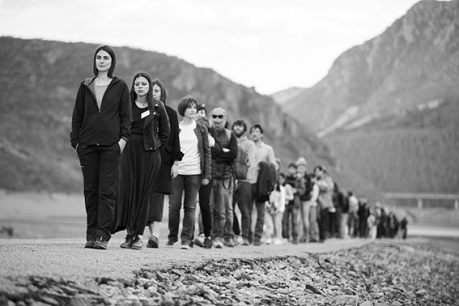
Artist, Hamish Fulton, Walking On and Off the Path (2016), A walk around the west side of a mountain range, Picos de Europa in Northern Spain. Commissioned by Fundación Cerezales Antonino y Cinia, Spain.

Kathy Prendergast, City Drawings, London, 1997 Photo Source: Kerlin Gallery, Dublin, http://www.kerlingallery.com
“The map no longer offers itself as a narrative, or indeed as an interpretative tool, but is instead transformed by drawing into a zone of the imagination. This practice relates as much to a long history of artists using map images as a way of accessing states of mind and the unknown as it does to conventional map making” Reference, Frances Morris, Tate Britain, “Prendergast: City Drawings.”
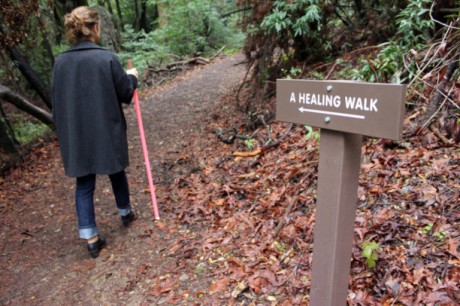
Photo: Artist Susan O’Malley, A Healing Walk, commissioned by the Montalvo Arts Centre, Saratoga California
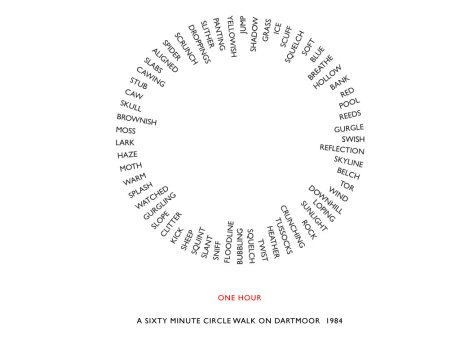
Artwork above by artist Richard Long who creates Textworks with words listing what is observed on a walk, its duration and location. Richard Long (www.richardlong.org) is a walking artist, who began his career with “A Line Made by Walking.”

Photograph: Richard Long, A Line Made by Walking, 1967.


Artworks by Fiona Robinson, Circular Walk Drawings, 2007, http://www.fionarobinson.wordpresss.com
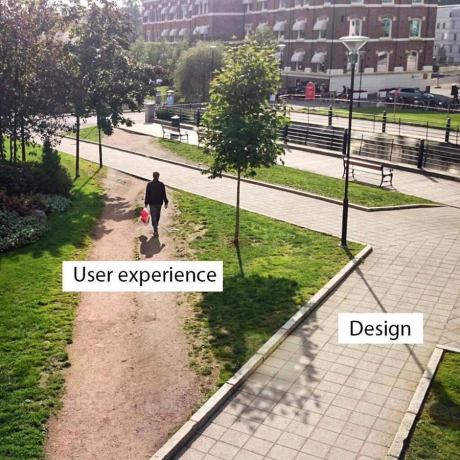
Photo Credit: Natalia Klishina
DESIRE LINES: CHOOSING TO WALK AWAY FROM AN ESTABLISHED ROUTE. A PERSONAL CHOICE. A CHANCE TO IMPROVISE AND BE INVENTIVE. SOMETIMES CALLED SOCIAL TRAILS, THEY ARE A WAY TO BE WITH OTHERS WHO HAVE ALSO DECIDED TO VEER AWAY. CONSIDERED A FORM OF DISOBEDIENCE, A SOCIAL CONSENSUS, AND A WAY TO BE MORE EFFICIENT IN PUBLIC SPACE, DESIRE LINES ARE DRAWN WITH SELF-DETERMINATION AND AGENCY—”DRAWINGS WE HAVE LIVED.” (GASTON BACHELARD, THE POETICS OF SPACE).
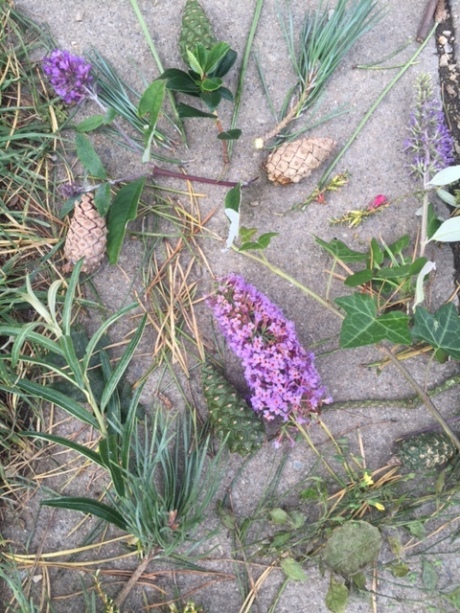

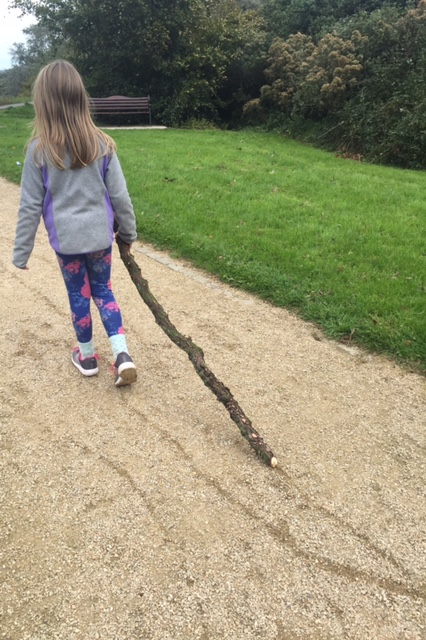
Photos Above: The Art of Walking—artworks created on a footpath beside Castletown River, Co. Louth, Ireland and a young participant creating a line while walking. The walk was an intergenerational collective of walking artists of all ages. Participants created artworks from natural collections which were left on footpaths, and made artworks with imprints from flowers and botanical finds.


Photos Above by Santoshi Roberston Davis, The Art of Walking at the Canadian Art Therapy Association Conference in Montreal. The workshop for conference participants included a walk to the gardens of the former Grey Nuns Convent (now part of Concordia University), and the Canadian Centre for Architecture sculpture park, gallery, and gardens. The walk was researched by Janis Timm-Bottos (Associate Professor, Art Therapy, Concordia University), so that each stop included a historical and social context for participants to better understand the significance of every location along the walking route.

“Last Friday, I toured the streets of Vancouver blindfolded, guided by a woman I’d never met before – and had never seen. Do You See What I Mean? is a work of one-on-one theatre created by Lyon, France-based choreographers/artists Martin Chaput and Martial Chazallon, whose company Projet in situ describes the work as “the choreography of participation.” They’ve mounted the piece – tailored for each place – in several cities, including Montreal; it’s now in Vancouver, as part of the PuSh International Performing Arts Festival.
This was a rare moment: when my thoughts drifted beyond what was directly in front of me. During the tour, you are totally focused on your experience and its implications. You’re not checking your phone, you’re not casing the room, you’re not thinking about anything other than the steps you’re climbing, the lavender pastry you’re tasting, the exchange you are having with your guide. Your mind does not wander at all. At least mine didn’t – and that is a feat for me. I didn’t – couldn’t – take a single note. But I remember everything. Do You See What I Mean? is set firmly in the world we’re already in, but have long forgotten to notice. We become intrigued again with the streets we walk every day” (Extracts by Marsha Lederman, ‘Why I Walked Blindfolded in Vancouver for Two Hours’)
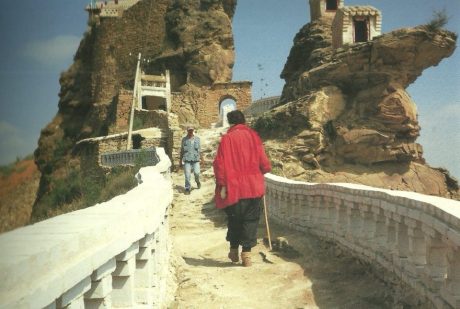
Marina Abramovic and Ulay, The Great Wall Walk (1988). The meeting of Marina and Ulay after each walked 90 days from either end of the Great Wall of China. While initially planned as a celebration of their twelve year artistic and personal relationship, their meeting (documented above) marked the end of their collaboration and partnership.
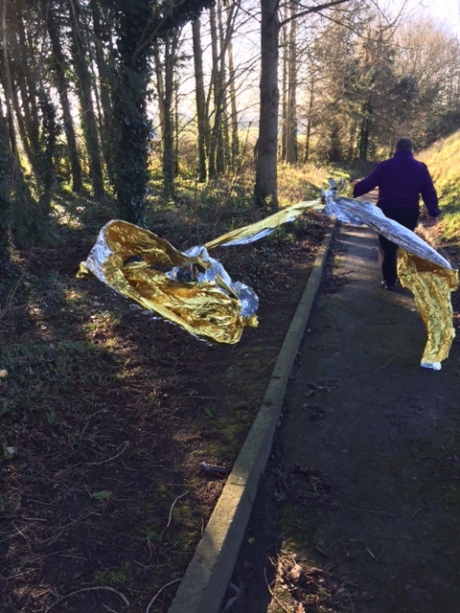
Photo: A walk in an art therapy forest studio, Ireland.
Further Reading
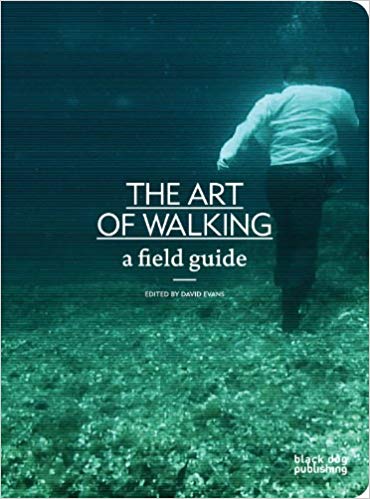

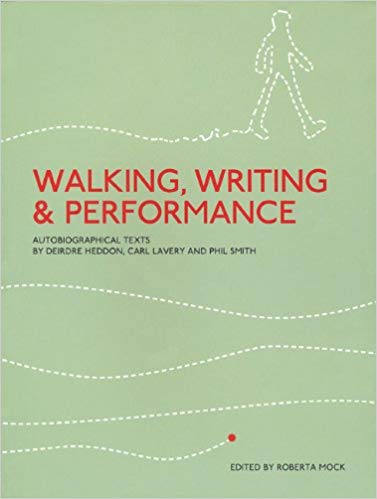

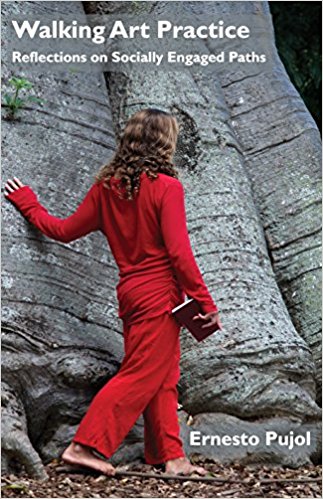
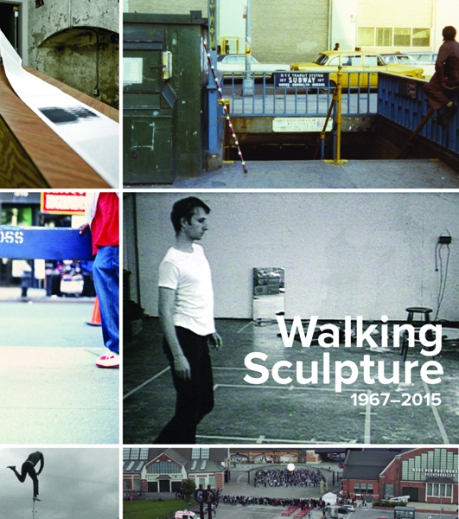
WALK: University of Sunderland’s Walking Art, Landskip and Knowledge Research Group
A Listing of Walking Artists by www.glasstire.com/The Ten List: Walks as Art
Walk Poems: A Series of Reviews of Walking Projects by Louis Bury and Corey Frost
The Loiterers Resistance Movement
The Sideways Art Festival, A Walking Expedition through Belgium
Walking Artists to Discover
Richard Long, Hamish Fulton, Alec Finlay, Marina Abramovic, Chris Drury, Mike Collier, Brian Thompson, Tim Brennan, Tim Robinson, Julian Opie, Bruce Nauman, Melanie Manchot, Richard Wentworth, Francis Alÿs, Janet Cardiff, Atul Bhalla, Simon Pope, Sophie Calle, plan b, Wrights & Sites, Dan Holdsworth, Rachel Reupke. Joe Bateman, Brendan Stuart Burns, Rachael Clewlow, Sarah Cullen, Bradley Davies, Tracy Hannah, James Hugonin, Tim Knowles, Pat Naldi & Wendy Kirkup, Ingrid Pollard, Bryndis Snæbjõrnsdóttir & Mark Wilson, walkwalkwalk, Jeremy Wood, Catherine Yass, Carey Young.
